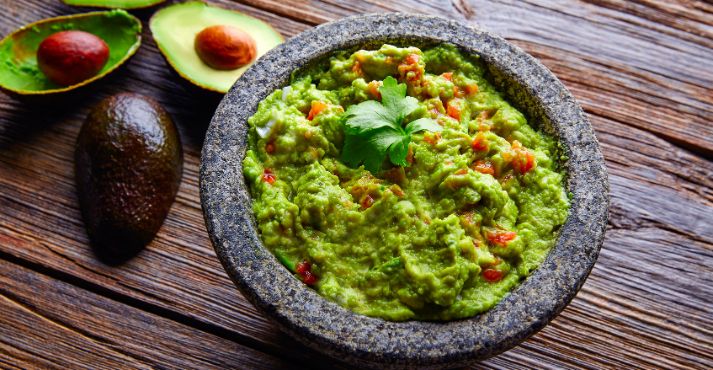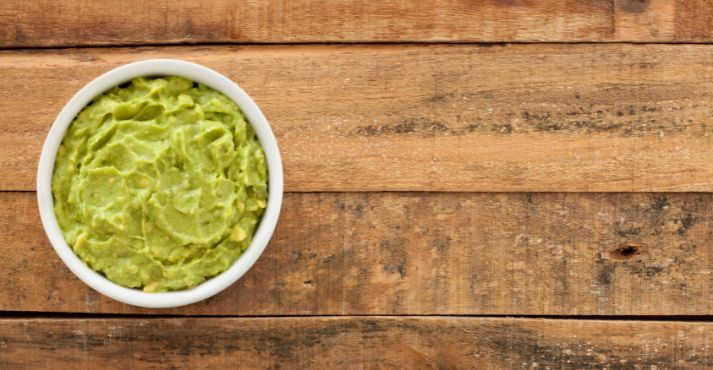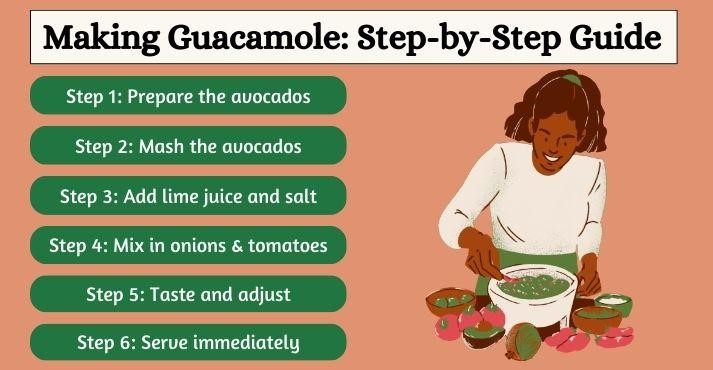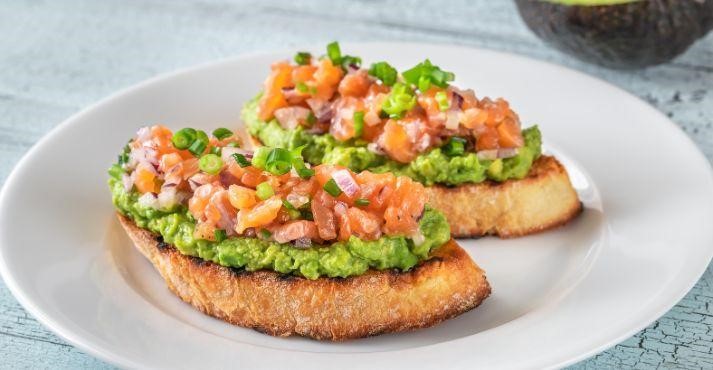Why is guacamole such a beloved dip worldwide? Known for its rich, creamy texture and refreshing flavors, guacamole has captured many’s hearts and taste buds.
But what makes this dish famous in homes, restaurants, and the food industry?
Whether you’re a fan of the classic dip or want to explore new twists, guacamole is made of simple, fresh ingredients that can be enjoyed in various ways.
In this article, we’ll explore about guacamole, its core ingredients, how to make it, and innovative ways to serve it.
What is Guacamole?

Guacamole is a traditional Mexican dip primarily made from mashed avocados. It originated in the Aztec Empire, where it was known as “ahuacamolli,” meaning “avocado sauce.”
This ancient vegan food dish has since evolved and spread globally, becoming a staple in casual dining and upscale restaurants and even a favorite of a flexitarian diet, including plant-based foods like avocados.
The simplicity of its ingredients has allowed guacamole recipe variations to emerge, catering to different tastes and culinary traditions.
As snack industry trends continue emphasizing healthier, natural food options, guacamole is nutritious and delicious. Its creamy, rich texture is complemented by critical ingredients that balance its flavors.
Over time, guacamole has been adopted in a wide range of cuisines, not just in its native Mexican culture.
The Core Ingredients of Guacamole

The magic of guacamole lies in the few essential ingredients that come together to create a flavorful and nutritious dip. These ingredients are easy to source and can be found in almost any kitchen:
- Avocados are the main ingredient. They are nutrient-dense and provide the creamy base that makes guacamole irresistible. They’re also rich in healthy fats, vitamins, and fiber, making guacamole a healthy choice.
- Lime: Lime juice adds a refreshing acidity that balances the richness of the avocado. It also helps prevent oxidation, keeping the guacamole green and fresh for longer.
- Salt: A dash of salt brings out the avocado’s natural flavors and balances the dish’s overall taste.
- Onions: Finely chopped onions add a bit of crunch and pungency to the guacamole, contrasting the creamy texture.
- Cilantro: Fresh cilantro adds an herbaceous note that gives guacamole its distinct flavor. It’s often used in traditional Mexican recipes.
- Tomatoes: Diced tomatoes are optional but frequently included to add a bit of sweetness and extra texture.
These simple ingredients give guacamole its signature taste and make it a popular dip or topping worldwide.
How to Make the Best Guacamole: Step-by-Step Guide

How do I make guacamole? The good news is that it’s incredibly easy. With just a handful of ingredients and a few minutes of prep time, you’ll have a fresh bowl of guacamole ready to enjoy. Here’s a detailed recipe to start making the best guacamole.
Ingredients
- 3 ripe avocados
- 1 lime, juiced
- 1/2 teaspoon salt
- 1/2 small onion, finely chopped
- 2 Roma tomatoes, diced
- 1 tablespoon fresh cilantro, chopped
- 1 clove garlic, minced (optional)
Instructions
- Prepare the avocados: Slice the avocados in half. Remove the pit, then scoop the flesh into a bowl.
- Mash the avocados: Use a fork or potato masher to mash the avocados. You can keep it chunky or mash until smooth, depending on your preference.
- Add lime juice and salt: Squeeze the lime juice over the mashed avocados and sprinkle the salt. The lime juice develops flavor and helps prevent the avocado from turning brown.
- Mix the onions and tomatoes: Add the finely chopped onions, diced tomatoes, and cilantro into the mashed avocados. Stir gently to combine all the ingredients evenly.
- Taste and adjust: Taste the guacamole and adjust the seasoning as needed. I suggest adding more salt or lime juice, depending on your taste.
- Serve immediately: For the freshest flavor, serve the guacamole immediately. If you need to wait to serve fresh, flavorful guac, see our storage tips below.
Now you know how to make guac that’s fresh, flavorful, and perfect for any occasion!
Flavor Variations and Additions
If you’re ready to improve your guacamole recipe, try incorporating some exciting new flavors. Here are a few popular flavor variations and additions that can make your guacamole stand out.
- Fruit Additions: Add diced mango, pineapple, or even pomegranate seeds for a sweet and tangy twist. This is a great way to balance the avocado’s creaminess with a bit of fruity brightness.
- Spices: Want to add some depth of flavor? A sprinkle of cumin, chili powder, or smoked paprika can elevate your guacamole. These spices give it a warmer, more complex flavor that pairs well with various dishes.
- Garnishes: Topping your guacamole with fresh cilantro, chopped jalapeños, or lime wedges can enhance flavor and presentation. For a crunchy texture, try garnishing with crushed tortilla chips.
Exploring these flavor variations can transform a simple dish into a bold, flavorful snack or side unique to your preferences.
Whether you’re sticking to a classic recipe for guacamole or trying something new, these additions will help keep things interesting.
Serving Suggestions and Pairings

Guacamole is more than just a dip for tortilla chips. Its versatility allows it to shine in a wide variety of dishes, whether you’re cooking at home or running a restaurant.
Best Uses in Restaurants
Guacamole is often paired with classic Mexican dishes like tacos, burritos, or nachos in restaurants. However, its creamy texture and rich flavor make it a great addition to other types of cuisine.
Guacamole might be a topping for grilled meats, served with roasted vegetables, or even used in flexitarian diet menus that emphasize plant-based ingredients.
Many chefs incorporate guacamole into upscale dishes, presenting it alongside seared tuna or as a spread on artisanal bread for an inspired appetizer. Guacamole can even be found in fusion cuisines, combining with flavors worldwide to create something new.
Innovative Serving Ideas
Are you looking to get creative with making guac part of a more upscale or innovative dining experience? Here are some ideas:
- Guacamole Deviled Eggs: For a modern twist on a classic appetizer, replace the traditional egg yolk filling with guacamole.
- Guacamole-stuffed Mushrooms: Fill mushroom caps with guacamole and bake them for a warm, savory bite.
- Guacamole and Sweet Potato Toast: Swap out bread for roasted sweet potato slices and top them with guacamole for a unique take on avocado toast.
These snacks industry trends show that guacamole isn’t just for casual dining. With some creativity, you can transform this simple dish into something truly memorable for your guests or customers.
Tips for Storing and Serving Guacamole
One of the biggest challenges with guacamole is keeping it fresh. Avocados tend to oxidize quickly, which can turn your guacamole brown. Luckily, there are a few easy ways to prevent this from happening and ensure your guacamole stays as fresh as possible.
- Prevent Oxidation: Cover the surface of the guacamole with plastic wrap, pressing the wrap directly onto the surface to eliminate air exposure. Alternatively, adding a thin lemon or lime juice layer can help prevent browning.
- Refrigerate: If you’re not serving your guacamole right away, store it in an airtight container in the refrigerator. Properly stored, guacamole can last up to 24 hours.
- Serve Fresh: Guacamole is best enjoyed fresh, so try to serve it immediately after making it. If you’re serving it at a party or event, keep it covered and chilled until ready.
Food Allergens in Guacamole
It’s important to consider food allergens when serving guacamole, especially in a restaurant setting. Although guacamole is generally free of common food allergens like gluten or dairy, some variations may include ingredients that could trigger allergies.
For example, if you decide to add certain spices, nuts, or other unexpected ingredients, always ensure proper labeling or ask about any food sensitivities.
Guacamole can often be a safe and delicious choice for customers with dietary restrictions, particularly when it’s kept simple.
The rise in wholesale food suppliers in Singapore specializing in allergen-free products highlights the importance of restaurants and individuals being aware of food allergens when serving traditional dishes like guacamole.
Agritech and Guacamole’s Future
As agritech innovations continue to reshape how we grow and source food, guacamole stands to benefit from these advancements.
Sustainable farming practices and technology have made growing avocados easier, with less impact on the environment. This means fresher, more affordable avocados for consumers, ensuring that guacamole remains a beloved dish for generations.
Incorporating agritech into the supply chain also means that guacamole can be made from avocados with fewer pesticides and less water waste. This benefits the environment and contributes to the final product’s overall quality and taste.
As food suppliers in Singapore and other regions adopt these technological advancements, the future of guacamole looks bright.
Conclusion
In short, what is guacamole? If not a simple, versatile dish, it has become a beloved staple worldwide. Whether you’re learning to make guacamole for the first time or are a seasoned expert, the possibilities are endless.
From the traditional guacamole recipe to unique variations that include fruits and spices, guacamole has something to offer everyone.
Its cultural roots, simple ingredients for guacamole, and adaptability have made it a favorite in kitchens and restaurants across the globe.
Guacamole’s flexibility and health benefits will likely make it a staple in everyday meals and upscale dining for years to come.
So, the next time you’re wondering how to make guac, remember that with a little creativity, the possibilities are endless. Enjoy the process, experiment with flavors, and make guacamole your own!





























